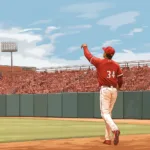 Do you want to learn The Science Behind Long Toss Training in Baseball? Then this is the NO BS article you have been looking for!
Do you want to learn The Science Behind Long Toss Training in Baseball? Then this is the NO BS article you have been looking for!
Throwing a baseball is a sophisticated and dynamic movement that involves the complete kinetic chain. Pitchers have evolved and enhanced their training routines to increase their pitching talents, just as batters continue to perfect their techniques and the game of baseball evolves. Higher velocity, longer pitch counts, and faster recovery between appearances are all goals. With the invention of the radar gun, pitchers and coaches have placed a premium on raising pitch velocity. This endeavor, however, may have certain pitfalls.
Baseball Injury Science
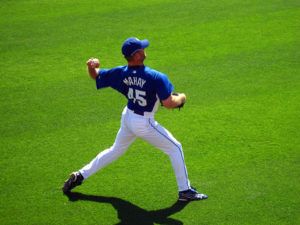 Pitchers are 34% more likely to be injured than position players in Major League Baseball, with the upper extremities accounting for a considerable share of these injuries (approximately two-thirds) [1]. Pitchers are more likely to get injured in high school, with a 37% injury rate compared to a 15% incidence for position players [2]. Elbow pain (26%) and shoulder discomfort (32%), which are frequently linked to overuse and exhaustion, are typical complaints among young pitchers [3]. These troubling figures have sparked a concerted effort to address and minimize the injury trend. Pitchers are increasingly devoting more time to strength training, namely core and lower extremity strength. They are also using weighted balls and performing ultra-long-distance throws to increase velocity, endurance, reduce injury risk, and speed up recovery from injuries.
Pitchers are 34% more likely to be injured than position players in Major League Baseball, with the upper extremities accounting for a considerable share of these injuries (approximately two-thirds) [1]. Pitchers are more likely to get injured in high school, with a 37% injury rate compared to a 15% incidence for position players [2]. Elbow pain (26%) and shoulder discomfort (32%), which are frequently linked to overuse and exhaustion, are typical complaints among young pitchers [3]. These troubling figures have sparked a concerted effort to address and minimize the injury trend. Pitchers are increasingly devoting more time to strength training, namely core and lower extremity strength. They are also using weighted balls and performing ultra-long-distance throws to increase velocity, endurance, reduce injury risk, and speed up recovery from injuries.
Long Toss Training: The Art and Science
Long toss has been an important component of throwing programs for many years, providing a way to develop arm strength, throwing endurance, glenohumeral range of motion, velocity, and injury risk [4-6]. During the 1990s and early 2000s, specific throwing programs were developed and published, with a focus on regulated throw numbers and distances [5-8]. Long toss was originally developed for rehabilitation after surgery or injury, but it has since found a place in preseason, postseason, and even in-season throwing regimens. It helps to increase and maintain arm strength, improve shoulder range of motion, and prepare pitchers for longer and more frequent outings.
Unraveling Kinematic and Kinetic Changes in the Science of Long Toss Training
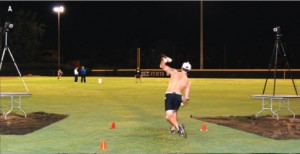 According to Stone and colleagues' research, the majority of pitchers include long tosses in their regimen to extend and expand their throwing arm [11]. The purpose of a recent study headed by Luo et al. was to investigate the effects of two types of long tosses, namely straight-line long-toss (SLT) and ultra-long-toss (ULT), on the shoulder range of motion of 24 Division I baseball pitchers in the National Collegiate Athletic Association (NCAA). The study's findings revealed a significant increase in passive exterior rotation following both SLT and ULT throwing, but no significant improvement in passive internal rotation [14]. Surprisingly, the difference between the SLT and ULT groups was not statistically significant, despite the considerable increase in external rotation following the long-toss. Post-pitching stretching programs have traditionally focused on minimizing internal rotation loss; however, Luo et al.'s study indicated that neither SLT nor ULT had a significant impact on internal rotation.
According to Stone and colleagues' research, the majority of pitchers include long tosses in their regimen to extend and expand their throwing arm [11]. The purpose of a recent study headed by Luo et al. was to investigate the effects of two types of long tosses, namely straight-line long-toss (SLT) and ultra-long-toss (ULT), on the shoulder range of motion of 24 Division I baseball pitchers in the National Collegiate Athletic Association (NCAA). The study's findings revealed a significant increase in passive exterior rotation following both SLT and ULT throwing, but no significant improvement in passive internal rotation [14]. Surprisingly, the difference between the SLT and ULT groups was not statistically significant, despite the considerable increase in external rotation following the long-toss. Post-pitching stretching programs have traditionally focused on minimizing internal rotation loss; however, Luo et al.'s study indicated that neither SLT nor ULT had a significant impact on internal rotation.
Previous biomechanical studies offered light on the effects of long-toss training. Long-tossing has been proven in trials to reduce the arm slot, increase arm speed, and improve arm rotation [9, 13]. Camp et al. investigated the biomechanical parameters that contribute to higher elbow varus torque, which included a reduced arm slot, greater arm speed, and increased arm rotation [12]. This investigation highlighted the potential dangers of long-toss activities, notably their direct relationship with elbow varus torque. It's worth mentioning that torque measurements were obtained utilizing a one-sensor methodology, implying that more research in this area is needed for a complete understanding.
Risk of Maximum-Distance Long Toss Training
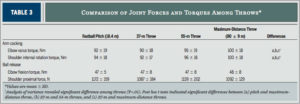 Fleisig and colleagues' research has revealed insights into the mechanics of long-toss throwing. They discovered that throwing the ball hard and in a straight line for lengths of up to 180 feet has biomechanics similar to pitching from a mound. Significant mechanical changes occur, however, once the throw reaches its maximum distance [9]. This deviation from typical mechanics is an adaptive reaction to the different demands of maximum-distance throwing versus mound pitching. This mechanical change is analogous to the difference between long-distance running and sprinting mechanics. Long-toss exercises should be carefully monitored and may be performed at a lower intensity to reduce the risk of injury. Maximum distance throwing is unadvised in the TopVelocity Program.
Fleisig and colleagues' research has revealed insights into the mechanics of long-toss throwing. They discovered that throwing the ball hard and in a straight line for lengths of up to 180 feet has biomechanics similar to pitching from a mound. Significant mechanical changes occur, however, once the throw reaches its maximum distance [9]. This deviation from typical mechanics is an adaptive reaction to the different demands of maximum-distance throwing versus mound pitching. This mechanical change is analogous to the difference between long-distance running and sprinting mechanics. Long-toss exercises should be carefully monitored and may be performed at a lower intensity to reduce the risk of injury. Maximum distance throwing is unadvised in the TopVelocity Program.
Surprisingly, despite the longer throw distance, pitchers use less effort during long toss. In other words, instead of throwing their fastest fastball, they use a slightly modified kinetic chain to get additional distance. However, introducing long-toss into throwing routines is a significant barrier. The apparent reduction in effort during long-distance throws may not always correspond to the real reduction in effort [11].
The 3X Pitching Velocity Program's Approach to Achieving Velocity Safely
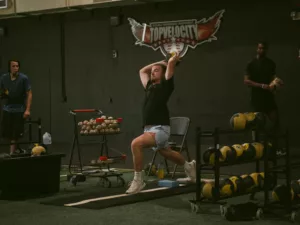 While long throw has long been a part of many pitchers' training regimens, the 3X Pitching Velocity Program takes a unique approach to maximize both velocity development and injury avoidance. Unlike the typical approach of including long toss throughout the training cycle, the 3X Pitching Velocity Program incorporates long tossing only during pre-season training, and even then, distance restrictions are enforced. This policy stems from the program's dedication to putting athlete safety and performance first.
While long throw has long been a part of many pitchers' training regimens, the 3X Pitching Velocity Program takes a unique approach to maximize both velocity development and injury avoidance. Unlike the typical approach of including long toss throughout the training cycle, the 3X Pitching Velocity Program incorporates long tossing only during pre-season training, and even then, distance restrictions are enforced. This policy stems from the program's dedication to putting athlete safety and performance first.
- No Need for Long Toss Training: The 3X Pitching Velocity Program dispels the myth that a long toss is required to increase pitch velocity or reduce injury risks. Instead, the program employs a thorough schedule that includes a variety of training modalities. Mobility training to increase joint flexibility, drill training to improve pitching mechanics, and Olympic-based strength and conditioning routines to increase power and endurance are all examples. Pitchers can accomplish their velocity goals without relying primarily on long throwing distances by using this comprehensive technique.
- Injury Prevention Priority: Recognizing the increasing injury rates among pitchers, the 3X Pitching Velocity Program promotes injury prevention while also enhancing performance. The program recognizes that extreme distance long tossing can cause arm strain and overuse issues. The approach protects pitchers from unnecessary injury risks by carefully limiting the distance and timing of long toss exercises. This emphasis on safety is critical to developing a long-term training regimen that fosters longevity in a pitcher's career.
- A Customized Approach: The 3X Pitching Velocity Program recognizes that each pitcher is unique, with their own set of strengths, weaknesses, and aspirations. As a result, the program tailors its training methods to fit the demands of each individual. This tailored strategy considers each pitcher's present skill level, physical condition, and goals. The approach maximizes the potential for velocity improvements while protecting against potential setbacks by combining scientific ideas and empirical expertise.
Finally, the 3X Pitching Velocity Program offers a novel approach to training for enhanced pitch velocity. The program not only cultivates velocity but also player safety by deviating from the traditional reliance on long toss and instead includes mobility training, drill training, and Olympic-based strength and conditioning. The emphasis on injury prevention, tailored approaches, and evidence-based procedures places the program at the forefront of modern baseball training, opening the road for athletes to flourish on the mound without jeopardizing their health.
You can purchase the program below or signup for TopVelocity Patreon which includes remote coaching with weekly video analysis!
FAQs: Long Toss Training
Q: Can pitchers of all ages participate in long toss?
A: Long toss can be beneficial to pitchers of all ages if done appropriately and gradually.
Q: Can long toss pitching take the place of traditional mound pitching?
A: No, long toss is a practice of increasing throwing volume and intensity. It should not be used as an alternative to throwing drills, or mound work.
Q: Is long toss good for your arm health?
A: Long toss can be safe when performed with proper mechanics and progressive growth.
Q: How does the long toss affect pitch velocity?
A: If performed moderately it will not affect performance but if performed at max distance it can hurt performance.
Q: How important is biomechanics in long toss training?
A: Biomechanics should be the main focus when long tossing but at max distance biomechanics begin to breakdown and dramatically change for the pitcher.
Q: Can long toss lessen injury risk?
A: Properly implemented long toss regimens, such as those developed by TopVelocity, provide an emphasis on injury avoidance through proper mechanics and progressive improvement.
Reference:
- Posner M, Cameron KL, Wolf JM, Belmont PJ, Owens BD. Epidemiology of Major League Baseball injuries. Am J Sports Med. 2011;39:1676–80.
-
Shanley E, Rauh MJ, Michener LA, Ellenbecker TS. Incidence of injuries in high school softball and baseball players. J Athl Train. 2011;46:648–54.
-
Lyman S, Fleisig GS, Waterbor JW, Funkhouser EM, Pulley L, Andrews JR, et al. Longitudinal study of elbow and shoulder pain in youth baseball pitchers. Med Sci Sports Exerc. 2001;33:1803–10.
-
Axe M, Hurd W, Snyder-Mackler L. Data-based interval throwing programs for baseball players. Sports Health. 2009;1:145–53.
-
Axe MJ, Snyder-Mackler L, Konin JG, StrubeMJ. Development of a distance-based interval throwing program for Little League-aged athletes. Am J Sports Med. 1996;24:594–602.
-
Axe MJ, Konin J. Distance based criteria interval throwing program. J Sport Rehabil. 1992;1:326–36.
-
Axe MJ, Wickham R, Snyder-Mackler L. Data-based interval throwing programs for little league, high school, college, and professional baseball pitchers. Sport Med Arthrosc. 2001;9:24–34.
-
Axe MJ, Windley TC, Snyder-Mackler L. Data-based interval throwing programs for collegiate softball players. J Athl Train. 2002;37:194–203.
-
Fleisig GS, Bolt B, Fortenbaugh D, Wilk KE, Andrews JR. Biomechanical comparison of baseball pitching and long-toss: implications for training and rehabilitation. J Orthop Sports Phys Ther. 2011;41:296–303.
-
Melugin HP, Larson DR, Fleisig GS, Conte S, Fealy SA, Dines JS, et al. Baseball pitchers’ perceived effort does not match actual measured effort during a structured long-toss throwing program. Am J Sports Med. 2019;47:1949–54. Study revealing that a pitcher's perceived effort does not match their actual effort during a long-toss throwing program—for every 25% decrease in perceived effort, the pitcher only decreased their velocity by 11% and elbow varus torque by 7%.
-
Stone AV, Mannava S, Patel A, Marquez-Lara A, Freehill MT. Defining the long-toss: a professional baseball epidemiological study. Orthop J Sport Med. 2017;5(2). https://doi.org/10.1177/2325967116686773.
-
Camp CL, Tubbs TG, Fleisig GS, Dines JS, Dines DM, Altchek DW, et al. The relationship of throwing arm mechanics and elbow varus torque: within-subject variation for professional baseball pitchers across 82,000 throws. Am J Sports Med. 2017;45:3030–5.
-
Dowling B, McNally MP, Laughlin WA, Onate JA. Changes in throwing arm mechanics at increased throwing distances during structured long-toss. Am J Sports Med. 2018;46:3002–6. Study demonstrating the changes in arm biomechanics with increasing long-toss distances, including an increase in arm rotation, arm speed, and elbow varus torque, and a decrease in arm slot.
-
Luo TD, Sciascia AD, Stone AV, Strahm JG, Mannava S, Waterman BR, et al. The effect of straight-line long-toss versus ultra-long-toss throwing on passive glenohumeral range of motion recovery after pitching. Sports Health. 2020. https://doi.org/10.1177/1941738120980016. Study demonstrating no significant difference in glenohumeral external rotation measurements after ultra-long-toss compared to straight-line long-toss.




